Genome-Wide Analysis of MAMSTR Transcription Factor-Binding Sites via ChIP-Seq in Porcine Skeletal Muscle Fibroblasts
Abstract
:Simple Summary
Abstract
1. Introduction
2. Materials and Methods
2.1. Porcine Myofibroblast Culture
2.2. Recombinant Adenovirus Packaging and Infection
2.3. ChIP Library Preparation and Sequencing
2.4. Peak Calling and Data Analysis
2.5. Gene Ontology (GO) and KEGG Pathway Enrichment Analysis for Peak-Associated Genes
2.6. RNA Extraction, RT-PCR, and ChIP-qPCR
2.7. Gene Promoter Cloning and Luciferase Assays
3. Results
3.1. Effects of MAMSTR Genes on C2C12 Cells
3.2. Detection of MAMSTR mRNA and Protein Levels after Recombinant Adenovirus Infection
3.3. ChIP-Seq Analysis
3.4. Function and Pathway Enrichment Analysis of Peak-Associated Genes
3.5. Verification and Analysis of Potential Target Genes in the Promoter Region
4. Discussion
5. Conclusions
Supplementary Materials
Author Contributions
Funding
Institutional Review Board Statement
Informed Consent Statement
Data Availability Statement
Conflicts of Interest
References
- Listrat, A.; Lebret, B.; Louveau, I.; Astruc, T.; Bonnet, M.; Lefaucheur, L.; Picard, B.; Bugeon, J. How Muscle Structure and Composition Influence Meat and Flesh Quality. Sci. World J. 2016, 2016, 3182746. [Google Scholar] [CrossRef] [PubMed]
- Matarneh, S.K.; Silva, S.L.; Gerrard, D.E. New Insights in Muscle Biology that Alter Meat Quality. Annu. Rev. Anim. Biosci. 2021, 9, 355–377. [Google Scholar] [CrossRef] [PubMed]
- Abdelatty, A.M.; Mandouh, M.I.; Mousa, M.R.; Mansour, H.A.; Ford, H.; Shaheed, I.B.; Elolimy, A.A.; Prince, A.; El-Sawy, M.A.; AbuBakr, H.O.; et al. Sun-dried Azolla leaf meal at 10% dietary inclusion improved growth, meat quality, and increased skeletal muscle Ribosomal protein S6 kinase β1 abundance in growing rabbit. Animal 2021, 15, 100348. [Google Scholar] [CrossRef] [PubMed]
- Picard, B.; Gagaoua, M. Muscle Fiber Properties in Cattle and Their Relationships with Meat Qualities: An Overview. J. Agric. Food Chem. 2020, 68, 6021–6039. [Google Scholar] [CrossRef]
- Exeter, D.; Connell, D.A. Skeletal muscle: Functional anatomy and pathophysiology. Semin. Musculoskelet. Radiol. 2010, 14, 97–105. [Google Scholar] [CrossRef]
- Chal, J.; Pourquié, O. Making muscle: Skeletal myogenesis in vivo and in vitro. Development 2017, 144, 2104–2122. [Google Scholar] [CrossRef]
- Huang, Z.; Li, Q.; Li, M.; Li, C. Transcriptome analysis reveals the long intergenic noncoding RNAs contributed to skeletal muscle differences between Yorkshire and Tibetan pig. Sci. Rep. 2021, 11, 2622. [Google Scholar] [CrossRef]
- Zhang, J.; Liu, Y.L. MicroRNA in Skeletal Muscle: Its Crucial Roles in Signal Proteins, Mus cle Fiber Type, and Muscle Protein Synthesis. Curr. Protein Pept. Sci. 2017, 18, 579–588. [Google Scholar] [CrossRef]
- Ren, H.; Li, Y.; Tang, Z.; Yang, S.; Mu, Y.; Cui, W.; Ao, H.; Du, L.; Wang, L.; Li, K. Genomic structure, chromosomal localization and expression profile of a porcine long non-coding RNA isolated from long SAGE libraries. Anim. Genet. 2009, 40, 499–508. [Google Scholar] [CrossRef]
- Li, R.; Li, B.; Jiang, A.; Cao, Y.; Hou, L.; Zhang, Z.; Zhang, X.; Liu, H.; Kim, K.H.; Wu, W. Exploring the lncRNAs Related to Skeletal Muscle Fiber Types and Meat Quality Traits in Pigs. Genes 2020, 11, 883. [Google Scholar] [CrossRef]
- Creemers, E.E.; Sutherland, L.B.; Oh, J.; Barbosa, A.C.; Olson, E.N. Coactivation of MEF2 by the SAP domain proteins myocardin and MASTR. Mol. Cell 2006, 23, 83–96. [Google Scholar] [CrossRef]
- Wang, D.; Chang, P.S.; Wang, Z.; Sutherland, L.; Richardson, J.A.; Small, E.; Krieg, P.A.; Olson, E.N. Activation of cardiac gene expression by myocardin, a transcriptional cofactor for serum response factor. Cell 2001, 105, 851–862. [Google Scholar] [CrossRef]
- Edmondson, D.G.; Lyons, G.E.; Martin, J.F.; Olson, E.N. Mef2 gene expression marks the cardiac and skeletal muscle lineages during mouse embryogenesis. Development 1994, 120, 1251–1263. [Google Scholar] [CrossRef]
- Wu, H.; Olson, E.N. Activation of the MEF2 transcription factor in skeletal muscles from myotonic mice. J. Clin. Investig. 2002, 109, 1327–1333. [Google Scholar] [CrossRef]
- Mokalled, M.H.; Johnson, A.N.; Creemers, E.E.; Olson, E.N. MASTR directs MyoD-dependent satellite cell differentiation during skeletal muscle regeneration. Genes Dev. 2012, 26, 190–202. [Google Scholar] [CrossRef]
- Carr, C.C.; Morgan, J.B.; Berg, E.P.; Carter, S.D.; Ray, F.K. Growth performance, carcass composition, quality, and enhancement treatment of fresh pork identified through deoxyribonucleic acid marker-assisted selection for the Rendement Napole gene. J. Anim. Sci. 2006, 84, 910–917. [Google Scholar] [CrossRef]
- Fujii, J.; Otsu, K.; Zorzato, F.; de Leon, S.; Khanna, V.K.; Weiler, J.E.; O’Brien, P.J.; MacLennan, D.H. Identification of a mutation in porcine ryanodine receptor associated with malignant hyperthermia. Science 1991, 253, 448–451. [Google Scholar] [CrossRef]
- Gerbens, F.; Verburg, F.J.; Van Moerkerk, H.T.; Engel, B.; Buist, W.; Veerkamp, J.H.; te Pas, M.F. Associations of heart and adipocyte fatty acid-binding protein gene expression with intramuscular fat content in pigs. J. Anim. Sci. 2001, 79, 347–354. [Google Scholar] [CrossRef]
- Van Laere, A.S.; Nguyen, M.; Braunschweig, M.; Nezer, C.; Collette, C.; Moreau, L.; Archibald, A.L.; Haley, C.S.; Buys, N.; Tally, M.; et al. A regulatory mutation in IGF2 causes a major QTL effect on muscle growth in the pig. Nature 2003, 425, 832–836. [Google Scholar] [CrossRef]
- Bansal, M.; Mendiratta, G.; Anand, S.; Kushwaha, R.; Kim, R.; Kustagi, M.; Iyer, A.; Chaganti, R.S.; Califano, A.; Sumazin, P. Direct ChIP-Seq significance analysis improves target prediction. BMC Genom. 2015, 16 (Suppl. S5), S4. [Google Scholar] [CrossRef]
- Aleksic, J.; Russell, S. ChIPing away at the genome: The new frontier travel guide. Mol. Biosyst. 2009, 5, 1421–1428. [Google Scholar] [CrossRef] [PubMed]
- Barski, A.; Zhao, K. Genomic location analysis by ChIP-Seq. J. Cell. Biochem. 2009, 107, 11–18. [Google Scholar] [CrossRef] [PubMed]
- Zhang, Y.; Liu, T.; Meyer, C.A.; Eeckhoute, J.; Johnson, D.S.; Bernstein, B.E.; Nusbaum, C.; Myers, R.M.; Brown, M.; Li, W.; et al. Model-based analysis of ChIP-Seq (MACS). Genome Biol. 2008, 9, R137. [Google Scholar] [CrossRef] [PubMed]
- Bailey, T.L.; Johnson, J.; Grant, C.E.; Noble, W.S. The MEME Suite. Nucleic Acids Res. 2015, 43, W39–W49. [Google Scholar] [CrossRef]
- Chen, T.W.; Li, H.P.; Lee, C.C.; Gan, R.C.; Huang, P.J.; Wu, T.H.; Lee, C.Y.; Chang, Y.F.; Tang, P. ChIPseek, a web-based analysis tool for ChIP data. BMC Genom. 2014, 15, 539. [Google Scholar] [CrossRef]
- Huang, D.W.; Sherman, B.T.; Tan, Q.; Kir, J.; Liu, D.; Bryant, D.; Guo, Y.; Stephens, R.; Baseler, M.W.; Lane, H.C.; et al. DAVID Bioinformatics Resources: Expanded annotation database and novel algorithms to better extract biology from large gene lists. Nucleic Acids Res. 2007, 35, W169–W175. [Google Scholar] [CrossRef]
- Shannon, P.; Markiel, A.; Ozier, O.; Baliga, N.S.; Wang, J.T.; Ramage, D.; Amin, N.; Schwikowski, B.; Ideker, T. Cytoscape: A software environment for integrated models of biomolecular interaction networks. Genome Res. 2003, 13, 2498–2504. [Google Scholar] [CrossRef]
- Bindea, G.; Mlecnik, B.; Hackl, H.; Charoentong, P.; Tosolini, M.; Kirilovsky, A.; Fridman, W.H.; Pagès, F.; Trajanoski, Z.; Galon, J. ClueGO: A Cytoscape plug-in to decipher functionally grouped gene ontology and pathway annotation networks. Bioinformatics 2009, 25, 1091–1093. [Google Scholar] [CrossRef]
- Seaborne, R.A.E.; Ochala, J. The dawn of the functional genomics era in muscle physiology. J. Physiol. 2023, 601, 1343–1352. [Google Scholar] [CrossRef]
- Landt, S.G.; Marinov, G.K.; Kundaje, A.; Kheradpour, P.; Pauli, F.; Batzoglou, S.; Bernstein, B.E.; Bickel, P.; Brown, J.B.; Cayting, P.; et al. ChIP-seq guidelines and practices of the ENCODE and modENCODE consortia. Genome Res. 2012, 22, 1813–1831. [Google Scholar] [CrossRef]
- Abugessaisa, I.; Ramilowski, J.A.; Lizio, M.; Severin, J.; Hasegawa, A.; Harshbarger, J.; Kondo, A.; Noguchi, S.; Yip, C.W.; Ooi, J.L.C.; et al. FANTOM enters 20th year: Expansion of transcriptomic atlases and functional annotation of non-coding RNAs. Nucleic Acids Res. 2021, 49, D892–D898. [Google Scholar] [CrossRef]
- Jin, W.; Liu, M.; Peng, J.; Jiang, S. Function analysis of Mef2c promoter in muscle differentiation. Biotechnol. Appl. Biochem. 2017, 64, 647–656. [Google Scholar] [CrossRef]
- Li, R.; Meng, S.; Ji, M.; Rong, X.; You, Z.; Cai, C.; Guo, X.; Lu, C.; Liang, G.; Cao, G.; et al. HMG20A Inhibit Adipogenesis by Transcriptional and Epigenetic Regulation of MEF2C Expression. Int. J. Mol. Sci. 2022, 23, 10559. [Google Scholar] [CrossRef]
- Jeong, J.; Choi, K.H.; Kim, S.H.; Lee, D.K.; Oh, J.N.; Lee, M.; Choe, G.C.; Lee, C.K. Combination of cell signaling molecules can facilitate MYOD1-mediated myogenic transdifferentiation of pig fibroblasts. J. Anim. Sci. Biotechnol. 2021, 12, 64. [Google Scholar] [CrossRef]
- Meadows, S.M.; Warkman, A.S.; Salanga, M.C.; Small, E.M.; Krieg, P.A. The myocardin-related transcription factor, MASTR, cooperates with MyoD to activate skeletal muscle gene expression. Proc. Natl. Acad. Sci. USA 2008, 105, 1545–1550. [Google Scholar] [CrossRef]
- Wang, Z.; Zhao, Q.; Li, X.; Yin, Z.; Chen, S.; Wu, S.; Yang, N.; Hou, Z. MYOD1 inhibits avian adipocyte differentiation via miRNA-206/KLF4 axis. J. Anim. Sci. Biotechnol. 2021, 12, 55. [Google Scholar] [CrossRef]
- Willows, R.; Navaratnam, N.; Lima, A.; Read, J.; Carling, D. Effect of different γ-subunit isoforms on the regulation of AMPK. Biochem. J. 2017, 474, 1741–1754. [Google Scholar] [CrossRef]
- Demeure, O.; Liaubet, L.; Riquet, J.; Milan, D. Determination of PRKAG1 coding sequence and mapping of PRKAG1 and PRKAG2 relatively to porcine back fat thickness QTL. Anim. Genet. 2004, 35, 123–125. [Google Scholar] [CrossRef]
- Su, Y.; Guo, P.; Ji, Y.B. Impact of AMPKgamma silencing on AMPK activation and intracellular lipids regulation. Yao Xue Xue Bao 2013, 48, 842–847. [Google Scholar]
- Wang, B.; Zhang, M.; Ni, Y.H.; Liu, F.; Fan, H.Q.; Fei, L.; Pan, X.Q.; Guo, M.; Chen, R.H.; Guo, X.R. Identification and characterization of NYGGF4, a novel gene containing a phosphotyrosine-binding (PTB) domain that stimulates 3T3-L1 preadipocytes proliferation. Gene 2006, 379, 132–140. [Google Scholar] [CrossRef]
- Qian, Y.; Zeng, Y.Q.; Du, J.F.; Cui, J.X.; Li, H.; Chen, Q.M.; Song, Y.P.; Chen, W. CDS cloning and relationship between intramuscular fat content and mRNA expression of PID1 gene in pig. Yi Chuan 2010, 32, 1153–1158. [Google Scholar] [PubMed]
- Chen, L.; Wang, X.Y.; Zhu, J.G.; You, L.H.; Wang, X.; Cui, X.W.; Shi, C.M.; Huang, F.Y.; Zhou, Y.H.; Yang, L.; et al. PID1 in adipocytes modulates whole-body glucose homeostasis. Biochim. Biophys. Acta Gene Regul. Mech. 2018, 1861, 125–132. [Google Scholar] [CrossRef] [PubMed]
- Yin, C.; Liu, W.H.; Liu, Y.; Wang, L.; Xiao, Y. PID1 alters the antilipolytic action of insulin and increases lipolysis via inhibition of AKT/PKA pathway activation. PLoS ONE 2019, 14, e0214606. [Google Scholar] [CrossRef]
- Zhu, S.; Cheng, G.; Zhu, H.; Guan, G. A study of genes involved in adipocyte differentiation. J. Pediatr. Endocrinol. Metab. 2015, 28, 93–99. [Google Scholar] [CrossRef] [PubMed]
- Yin, C.; Xiao, Y.; Zhang, W.; Xu, E.; Liu, W.; Yi, X.; Chang, M. DNA microarray analysis of genes differentially expressed in adipocyte differentiation. J. Biosci. 2014, 39, 415–423. [Google Scholar] [CrossRef]
- Huang, Z.; Zhang, M.; Plec, A.A.; Estill, S.J.; Cai, L.; Repa, J.J.; McKnight, S.L.; Tu, B.P. ACSS2 promotes systemic fat storage and utilization through selective regulation of genes involved in lipid metabolism. Proc. Natl. Acad. Sci. USA 2018, 115, E9499–E9506. [Google Scholar] [CrossRef]
- Yang, M.; Chen, X.; Zhang, J.; Xiong, E.; Wang, Q.; Fang, W.; Li, L.; Fei, F.; Gong, A. ME2 Promotes Proneural-Mesenchymal Transition and Lipogenesis in Glioblastoma. Front. Oncol. 2021, 11, 715593. [Google Scholar] [CrossRef]
- Faria, O.A.C.; Kawamoto, T.S.; Dias, L.R.O.; Fidelis, A.A.G.; Leme, L.O.; Caixeta, F.M.C.; Gomes, A.; Sprícigo, J.F.W.; Dode, M.A.N. Maturation system affects lipid accumulation in bovine oocytes. Reprod. Fertil. Dev. 2021, 33, 372–380. [Google Scholar] [CrossRef]
- Gan, S.; Mao, J.; Pan, Y.; Tang, J.; Qiu, Z. hsa-miR-15b-5p regulates the proliferation and apoptosis of human vascular smooth muscle cells by targeting the ACSS2/PTGS2 axis. Exp. Ther. Med. 2021, 22, 1208. [Google Scholar] [CrossRef]
- Zhou, Z.; Ren, Y.; Yang, J.; Liu, M.; Shi, X.; Luo, W.; Fung, K.M.; Xu, C.; Bronze, M.S.; Zhang, Y.; et al. Acetyl-Coenzyme A Synthetase 2 Potentiates Macropinocytosis and Muscle Wasting through Metabolic Reprogramming in Pancreatic Cancer. Gastroenterology 2022, 163, 1281–1293.e1281. [Google Scholar] [CrossRef]

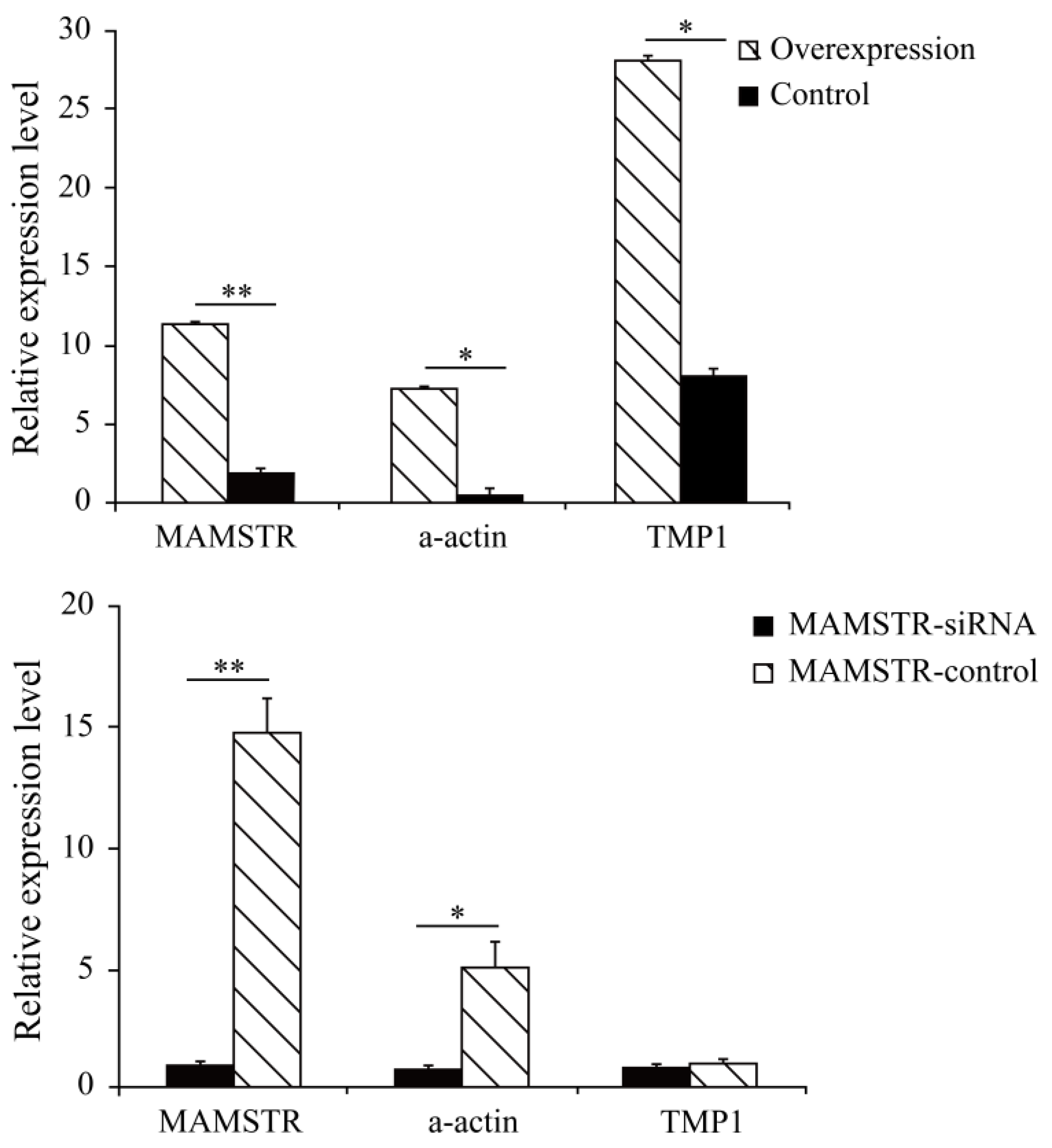

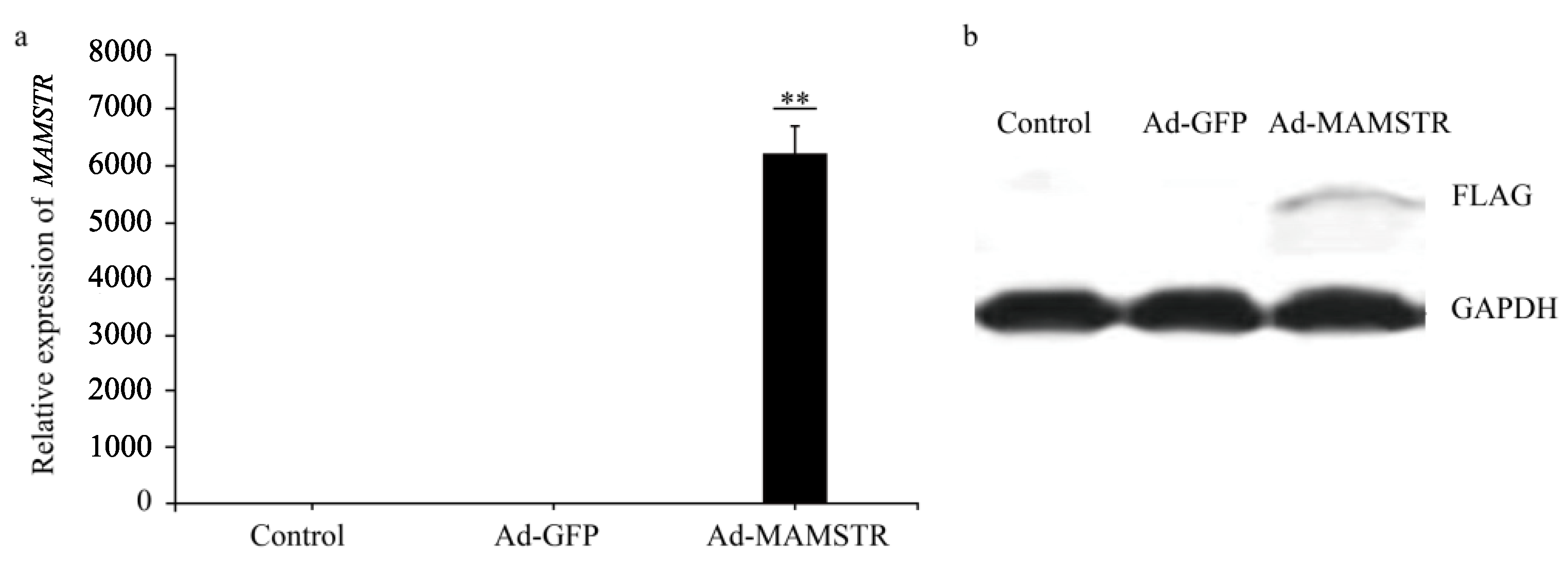
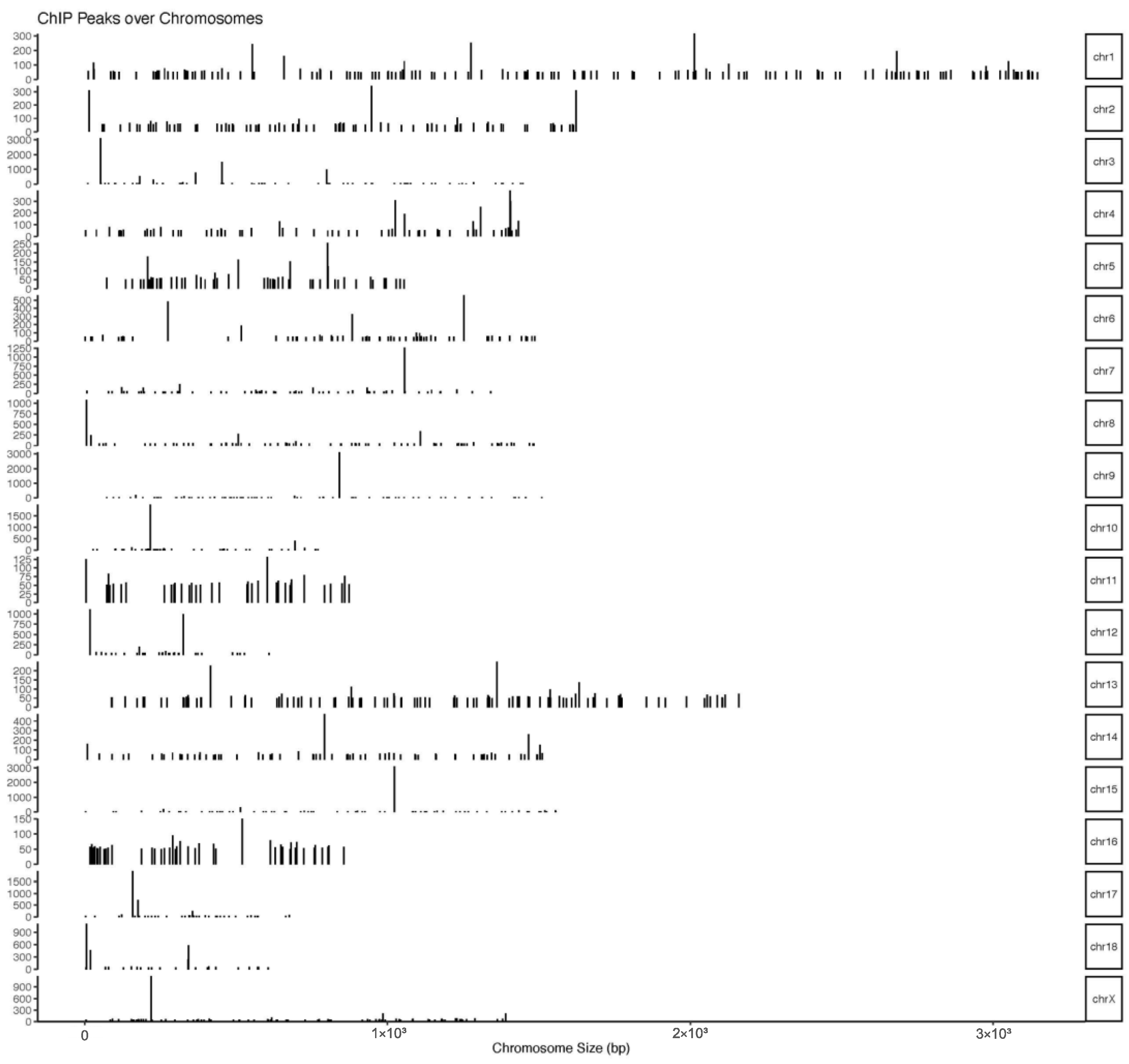

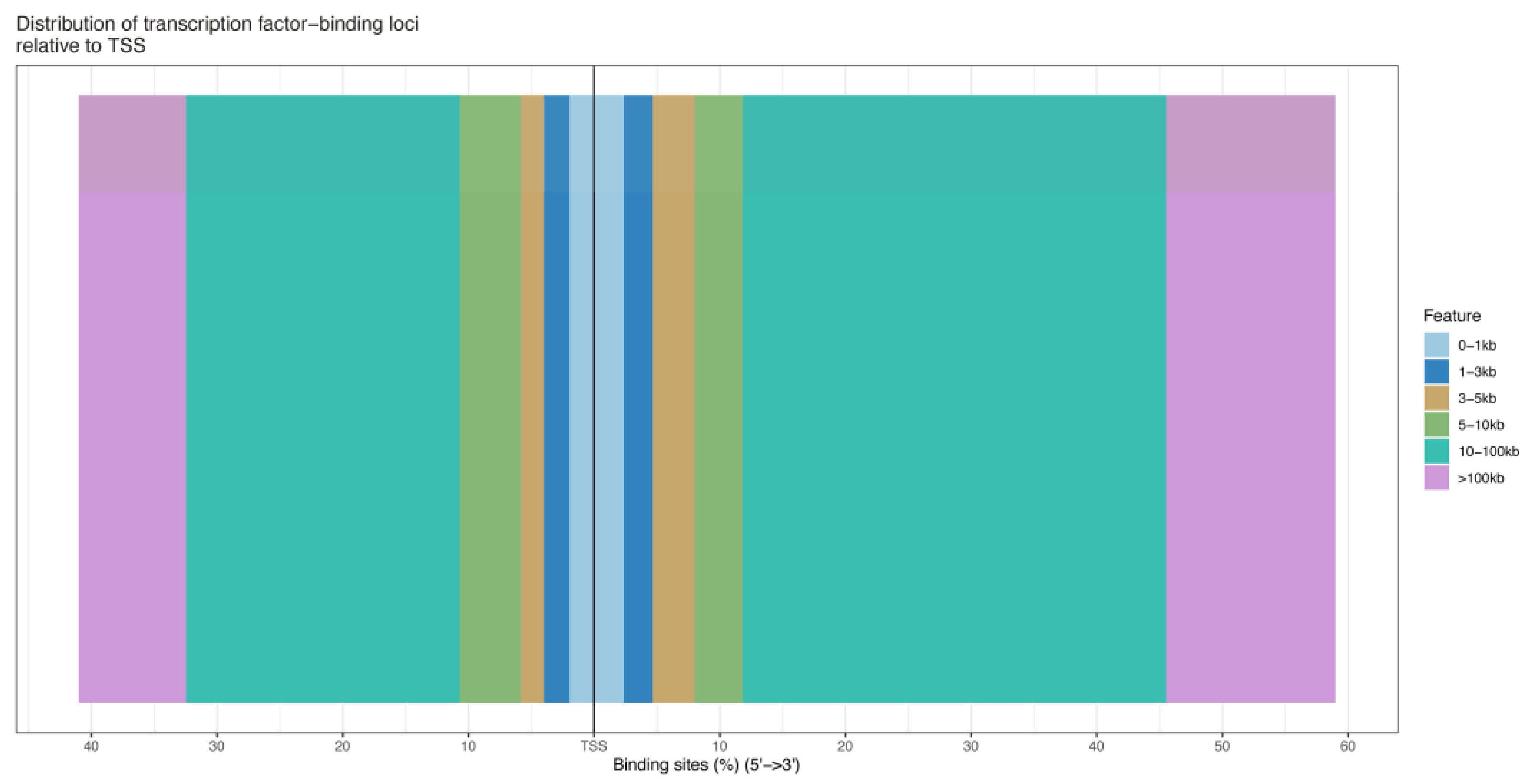

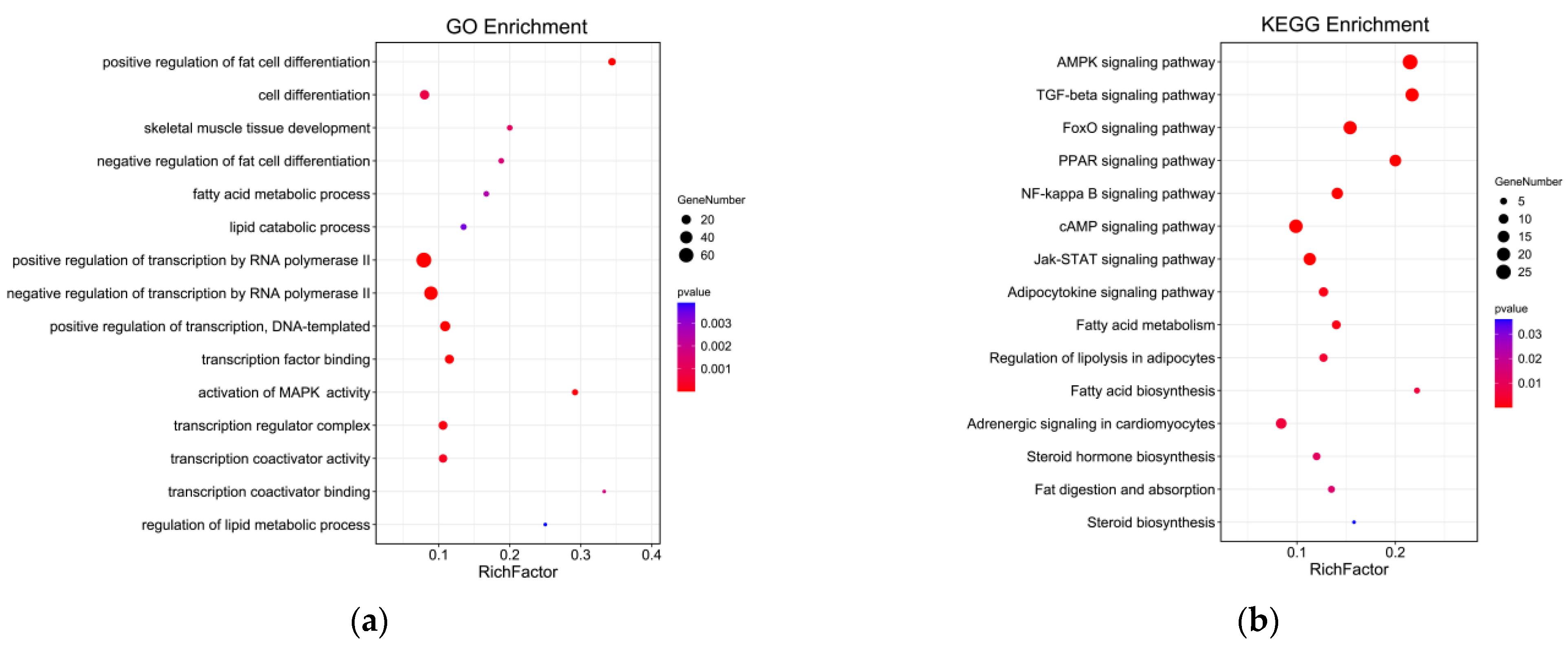


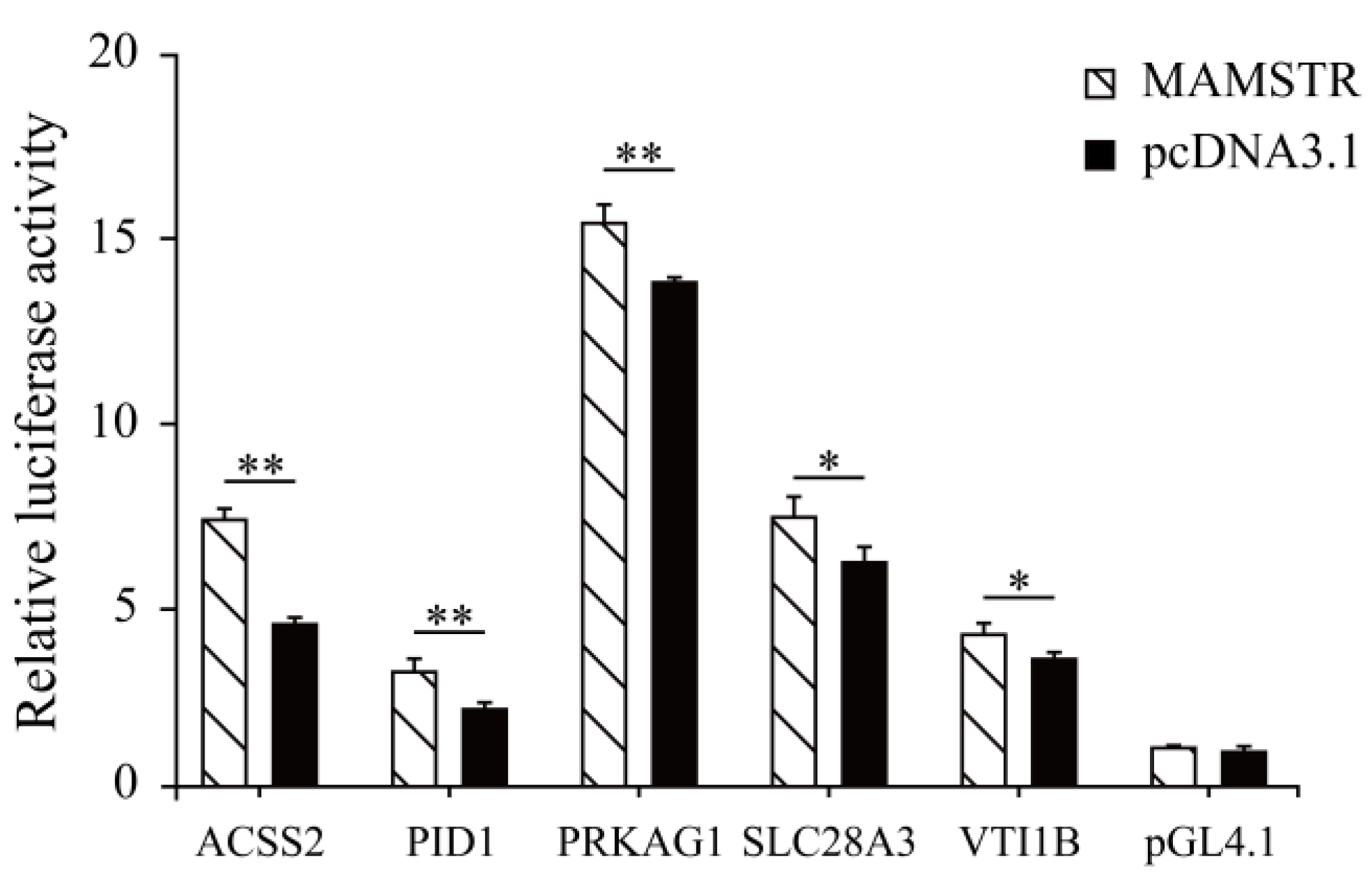
| Sample Name | Pass Solexa CHASTITY Quality Filter | Aligned (UCSC susScr3) |
|---|---|---|
| Ad-GFP-IP | 22,346,032 | 9,131,285 |
| Ad-GFP-Input | 26,074,155 | 19,952,766 |
| Ad-MAMSTR-IP | 27,937,935 | 10,623,701 |
| Ad-MAMSTR-Input | 32,682,601 | 22,873,420 |
| Refseq_Name | Symbol | Chr | TSS | TTS | Strand | Chr:Start–End | Length |
|---|---|---|---|---|---|---|---|
| NM_001143695 | ACSS2 | chr17 | 43455187 | 43510660 | + | chr17:43456618-43456877 | 260 |
| NM_214349 | PC | chr2 | 4605274 | 4609731 | + | chr2:4603905-4604407 | 503 |
| NM_001098594 | MLPH | chr15 | 151614165 | 151614293 | + | chr15:151613849-151614361 | 513 |
| NM_001001642 | PRKAG1 | chr5 | 15522471 | 15443954 | − | chr5:15520284-15520881 | 598 |
| NM_001173520 | PID1 | chr15 | 144255955 | 144256107 | + | chr15:144254596-144255197 | 602 |
| NM_001244146 | TRMT10A | chr8 | 130101783 | 130133413 | + | chr8:130100338-130100970 | 633 |
| NM_001098585 | AP3B1 | chr2 | 88719584 | 88534907 | − | chr2:88719756-88720316 | 561 |
| NM_001113702 | SLA-2 | chr7 | 24687093 | 24642158 | − | chr7:24688625-24689126 | 502 |
| NM_214437 | VTI1B | chr7 | 97720791 | 97693163 | − | chr7:97719717-97720147 | 431 |
| NM_001195370 | SPIN1 | chr1 | 32595576 | 32594555 | − | chr1:32594480-32595251 | 772 |
Disclaimer/Publisher’s Note: The statements, opinions and data contained in all publications are solely those of the individual author(s) and contributor(s) and not of MDPI and/or the editor(s). MDPI and/or the editor(s) disclaim responsibility for any injury to people or property resulting from any ideas, methods, instructions or products referred to in the content. |
© 2023 by the authors. Licensee MDPI, Basel, Switzerland. This article is an open access article distributed under the terms and conditions of the Creative Commons Attribution (CC BY) license (https://creativecommons.org/licenses/by/4.0/).
Share and Cite
Li, C.; Zhang, Z.; Wei, Y.; Qi, K.; Dou, Y.; Song, C.; Liu, Y.; Li, X.; Li, X.; Wang, K.; et al. Genome-Wide Analysis of MAMSTR Transcription Factor-Binding Sites via ChIP-Seq in Porcine Skeletal Muscle Fibroblasts. Animals 2023, 13, 1731. https://doi.org/10.3390/ani13111731
Li C, Zhang Z, Wei Y, Qi K, Dou Y, Song C, Liu Y, Li X, Li X, Wang K, et al. Genome-Wide Analysis of MAMSTR Transcription Factor-Binding Sites via ChIP-Seq in Porcine Skeletal Muscle Fibroblasts. Animals. 2023; 13(11):1731. https://doi.org/10.3390/ani13111731
Chicago/Turabian StyleLi, Chenlei, Zhe Zhang, Yilin Wei, Kunlong Qi, Yaqing Dou, Chenglei Song, Yingke Liu, Xinjian Li, Xiuling Li, Kejun Wang, and et al. 2023. "Genome-Wide Analysis of MAMSTR Transcription Factor-Binding Sites via ChIP-Seq in Porcine Skeletal Muscle Fibroblasts" Animals 13, no. 11: 1731. https://doi.org/10.3390/ani13111731





